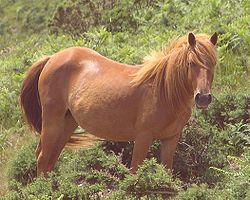| Chestnut | |
|---|---|
 A chestnut horse | |
| Other names | Red, sorrel, chesnut |
| Variants | Flaxen, Liver chestnut |
| Genotype | |
| Base color | Recessive extension "e" |
| Modifying genes | none |
| Description | reddish-brown color uniform over entire body other than markings |
| Phenotype | |
| Body | reddish-brown |
| Head and Legs | same as body, occasionally lighter |
| Mane and tail | flaxen to brown |
| Skin | Usually black, may be lighter at birth in some breeds |
| Eyes | Brown, eyes may be lighter at birth |
Chestnut is a hair coat color of horses consisting of a reddish-to-brown coat with a mane and tail the same or lighter in color than the coat. Chestnut is characterized by the absolute absence of true black hairs. It is one of the most common horse coat colors, seen in almost every breed of horse.
Chestnut is a very common coat color but the wide range of shades can cause confusion. The lightest chestnuts may be mistaken for palominos, while the darkest shades can be so dark they appear black. Chestnuts have dark brown eyes and black skin, and typically are some shade of red or reddish brown. The mane, tail, and legs may be lighter or darker than the body coat, but unlike the bay they are never truly black. Like any other color of horse, chestnuts may have pink skin with white hair where there are white markings, and if such white markings include one or both eyes, the eyes may be blue. Chestnut foals may be born with pinkish skin, which darkens shortly afterwards.[1][better source needed]
Chestnut is produced by a recessive gene. Unlike many coat colors, chestnut can be true-breeding; that is, assuming they carry no recessive modifiers like pearl or mushroom, the mating between two chestnuts will produce chestnut offspring every time. This can be seen in breeds such as the Suffolk Punch and Haflinger, which are exclusively chestnut. Other breeds including the American Belgian Draft and Budyonny are predominantly chestnut. However, a chestnut horse need not have two chestnut parents. This is especially apparent in breeds like the Friesian horse and Ariegeois pony which have been selected for many years to be uniformly black, but on rare occasions still produce chestnut foals.
- ^ "Foal Colors". Retrieved November 30, 2021.